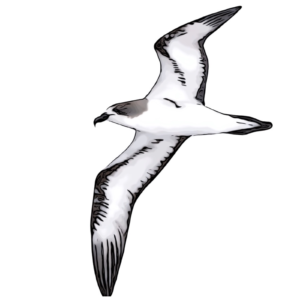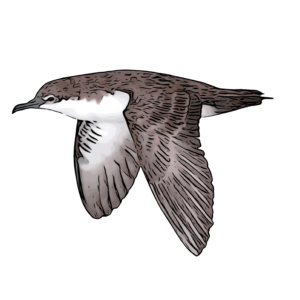Identification
Distinguished from similar Galapagos Shearwater by more slender appearance and larger size (while the petrel has a wingspan of roughly 1m, the shearwater has a wingspan of less than 70cm).
Description
A relitively large and slim petrel with a wingspan of roughly 1m. Upperparts are dark brown, appearing scalloped in some individuals while the underparts are white. A dark brown ‘mask’ extends from the side of the neck over the eye and the forehead is white. The underwing is boldly paterned with a pale center and dark edges – the dark brown line on the leading edge trails inwards closer to the body. A patch of brown feathers in the petrel’s ‘armpit’ is distinctive of the species, but my be reduced in some individuals.
Galapagos Distribution
Breeds on Isabela, Santa Cruz, Santiago, Floreana and San Cristobal in densely vegitated highlands, but can be seen at sea throughout the Galapagos Marine Reserve. It is uasually spotted on deep water crossing between islands, but may be seen flying to and from breeding sites at dusk and dawn.
Global Distribution
After breeding, these petrels forage across most of the central east Pacific, from N Peru to Central Mexico.
Status in the Galapagos
An uncommon endemic breeding visitor. The breeding season is highly variable and depends on individual colonies. For this reason, this species can be found in the Galapagos throughout the year.
Conservation
Ranked as Critacally endangered due to a rapid population decrease in recent years from roughly 30 000 breeding pairs in the early 1980’s to between 6000 and 15000 mature iindividuals currently. This decline was as a result of predation by introduced rats, dogs and pigs and habitat destruction by introduced plant species and overgrazing goats and cattle. During most seasons, this species’ breeding success is a slim 20%. An extensive conservation program has been established to save this species. It aims to eradicate introduced species, provide safe nesting sites and to establish new breeding colonies on predator-free islands by translocating chicks.


